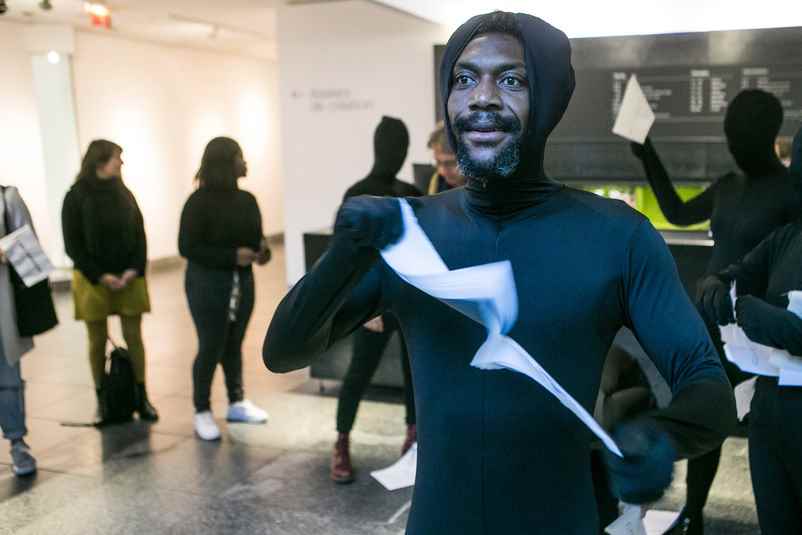Stanley February has made justice the spearhead of his artistic practice. Working to ensure that artists of diversity obtain the visibility to which they are entitled in the world of Quebec art, the Haitian-born artist is making things happen. The performative installation Contemporary Art Museum/Department of Invisibleswhich he presents from June 15 at the Montreal Museum of Fine Arts (MMFA), is an illustration of this.
Posted at 11:00 a.m.
It has been nearly six years since Stanley Juillet built his artistic credo on the equity to be achieved between museums and artists in Quebec. We remember his brilliant action, in 2019, at the Musée d’art contemporain de Montréal (MAC) when, with around fifty artists and students of diversity, he had disrupted the course of things, by l occurrence a vernissage, with a demonstration that aimed to claim more visibility in museums and art centers.

PHOTO MARTIN CHAMBERLAND, THE PRESS
MMFA Community Projects and Engagement curator Iris Amizlev and art historian Laura Delfino are the curators of Contemporary Art Museum/Department of Invisiblesby Stanley February.
Since then, he has continued to score points, forcing the art community to adopt an attitude more in keeping with the reality of Quebec society. In a symbolic action that mimics the institution of art, he has created a Museum of Visual Art/Department of the Invisibles, the MAADI, of which he is the “director general and chief curator”. A museum endowed with dozens of works that he has personally purchased in recent years from his fellow artists of diversity, especially black, too often ignored, he says.
Given the tradition of diversity that it has developed over the past fifteen years, the MMFA has therefore provided spaces to MAADI in order to give visibility to these artists who have become “invisible”. There are those who supported Stanley February from the start of his quest for fairness, in particular My-Van Dam, Eliza Olkinitskaya, Maria Ezcurra, Livia Daza-Paris, Clovis-Alexandre Desvarieux and Esther Calixte-Béa.

PHOTO MARTIN CHAMBERLAND, THE PRESS
Stanley February in front of the work Tenacious chimerasby the artist Oski (Joseph Alex Olivier Vilaire)
But also artists who present interesting and little-known work. Like Montserrat Duran Muntadas, which exploits textiles and glass and which has had little visibility, except with La Guilde, which has been making its works known for years. Or Claudia Bernal, who has an interdisciplinary practice of more than 30 years, and whose MAADI exhibits an installation that evokes the effects of colonialism and capitalism in Mexico.

PHOTO MARTIN CHAMBERLAND, THE PRESS
Installation view Urban shamanikaby Claudia Bernal, on the left
The works evoke the identity of the artists, their roots, their vibrations and this state of being which makes them fuses of life which, often, truly protect us from dread. The curators Laura Delfino and Iris Amizlev prepared the exhibition admirably, in a totally original way. With, in particular, an unusual density of works for a museum. “It’s revolutionary,” says Iris Amizlev. We have never seen anything like this. And the way Stanley created this exhibition, to share his power with 27 artists, is a community gesture, touching and extraordinary. »
-

PHOTO MARTIN CHAMBERLAND, THE PRESS
The painting Bwa Kayimanby Clovis-Alexandre Desvarieux
-

PHOTO PROVIDED BY THE MMFA
Shroud2019, Wilman Gomez Tamayo
-

PHOTO PROVIDED BY THE MMFA
Manditel/Tablecloth-apron2008, Maria Ezcurra
-

PHOTO PROVIDED BY THE MMFA
Looking forward2021, CODE BLANC: My-Van Dam, Stanley February, Maryam Izadifard
-

PHOTO MARTIN CHAMBERLAND, THE PRESS
Entities. 715,000,000,001—P, 2021-2022, Vanessa Suzanne
-

PHOTO MARTIN CHAMBERLAND, THE PRESS
transplanted garden2019-2020, Anahita Norouzi
-

PHOTO MARTIN CHAMBERLAND, THE PRESS
water memory2020-2022, Maryam Izadifard
1/7
Stanley February wonders why it has finally taken so many years for visual arts institutions to open the door to artists from minority sections of society, whether women, people of foreign origin or indigenous people. “I hope that from now on, we will be able to put in place structures for real transformation,” he said. No having to mimic the institution by colonizing it with my MAADI. The encounter is not to accept this exposure. The meeting is the beginning of a dialogue. These are commitments. We are at a stage and the institutions will have to go further. »

PHOTO MARTIN CHAMBERLAND, THE PRESS
Three works from the exhibition: top left, The forgotten, by Jésús Castro Rosas; top right, Baba and Anne, a painting by Muriel Ahmarani Jaouich; and in front, the cradle of Montserrat Duran Muntadas entitled while you were sleeping.
Stanley February will act as the boss of MAADI during performance-explanations which will take place in June and July, on Fridays and Saturdays, from 2 p.m. to 5 p.m. In addition, on Wednesday, June 15, at 5:30 p.m., in the museum’s Maxwell-Cumings auditorium, he will talk about his artistic career during a conference with independent curator Filipa Esteves and Iris Amizlev. In addition, to give the opportunity for an enlightening visit to this exhibition, the museum will provide resource guides on Thursday and Sunday, from 2 p.m. to 4 p.m.

